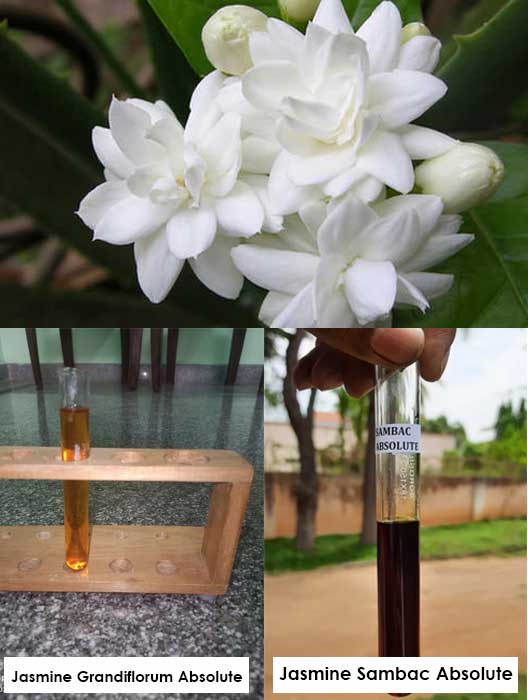JASMINE ABSOLUTES
 There is saying that ˇ° No perfume without Jasmineˇ± , very true if you consider that almost all fragrances do contain a touch of this exquisite odour. The odour of Jasmine is heady sensual deep and intoxicating. There are so many facets to a jasmine odour that it is impossible to describe in words. Three types of Jasmines that are used in Perfumery are Jasmine Grandiflorum, Jasmine Sambac and Jasmine Auriculatum. Grandiflorum and Sambac are the two most used. Whereas Grandiflorum has a deep sweet jam like odour sambac is green and calyx like.
There is saying that ˇ° No perfume without Jasmineˇ± , very true if you consider that almost all fragrances do contain a touch of this exquisite odour. The odour of Jasmine is heady sensual deep and intoxicating. There are so many facets to a jasmine odour that it is impossible to describe in words. Three types of Jasmines that are used in Perfumery are Jasmine Grandiflorum, Jasmine Sambac and Jasmine Auriculatum. Grandiflorum and Sambac are the two most used. Whereas Grandiflorum has a deep sweet jam like odour sambac is green and calyx like.
Jasmine (taxonomic name Jasminum is a genus of shrubs and vines in the olive family (Oleaceae). It contains around 200 species native to tropical and warm temperate regions of Europe, Asia, and Africa. Jasmines are widely cultivated for the characteristic fragrance of their flowers. A number of unrelated plants contain the word 'Jasmine' in their common names (see Other plants called 'Jasmine').Jasmines can be either deciduous (leaves falling in autumn) or evergreen (green all year round), and can be erect, spreading, or climbing shrubs and vines. Their leaves are borne opposite or alternate. They can be simple, trifoliate, or pinnate. The flowers are typically around 2.5 cm (0.98 in) in diameter. They are white or yellow in color, although in rare instances they can be slightly reddish.
The flowers are borne in cymose clusters with a minimum of three flowers, though they can also be solitary on the ends of branches. Each flower has about four to nine petals, two locules, and one to four ovules. They have two stamens with very short filaments. The bracts are linear or ovate. The calyx is bell-shaped. They are usually very fragrant. The fruits of jasmines are berries that turn black when ripe.The basic chromosome number of the genus is 13, and most species are diploid (2n=26). However, natural polyploidy exists, particularly in Jasminum sambac (2n=39), Jasminum flexile (2n=52),Jasminumprimulinum (2n=39), and Jasminumangustifolium (2n=52).Jasmines are native to tropical and subtropical regions of Asia, Africa, and Australia.
Among the 200 species, only one is native to Europe. Their center of diversity is in South Asia and Southeast Asia. Although not native to Europe, a number of jasmine species have become naturalized in Mediterranean Europe. For example, the so-called Spanish jasmine or Catalonian jasmine (Jasminumgrandiflorum) was originally from Iran and western South Asia, and is now naturalized in the Iberian peninsula.Jasminumfluminense (which is sometimes known by the inaccurate name "Brazilian Jasmine") and Jasminumdichotomum (Gold Coast Jasmine) are invasive species in Hawaii and Florida. Jasminumpolyanthum, also known as White Jasmine, is an invasive weed in Australia.
